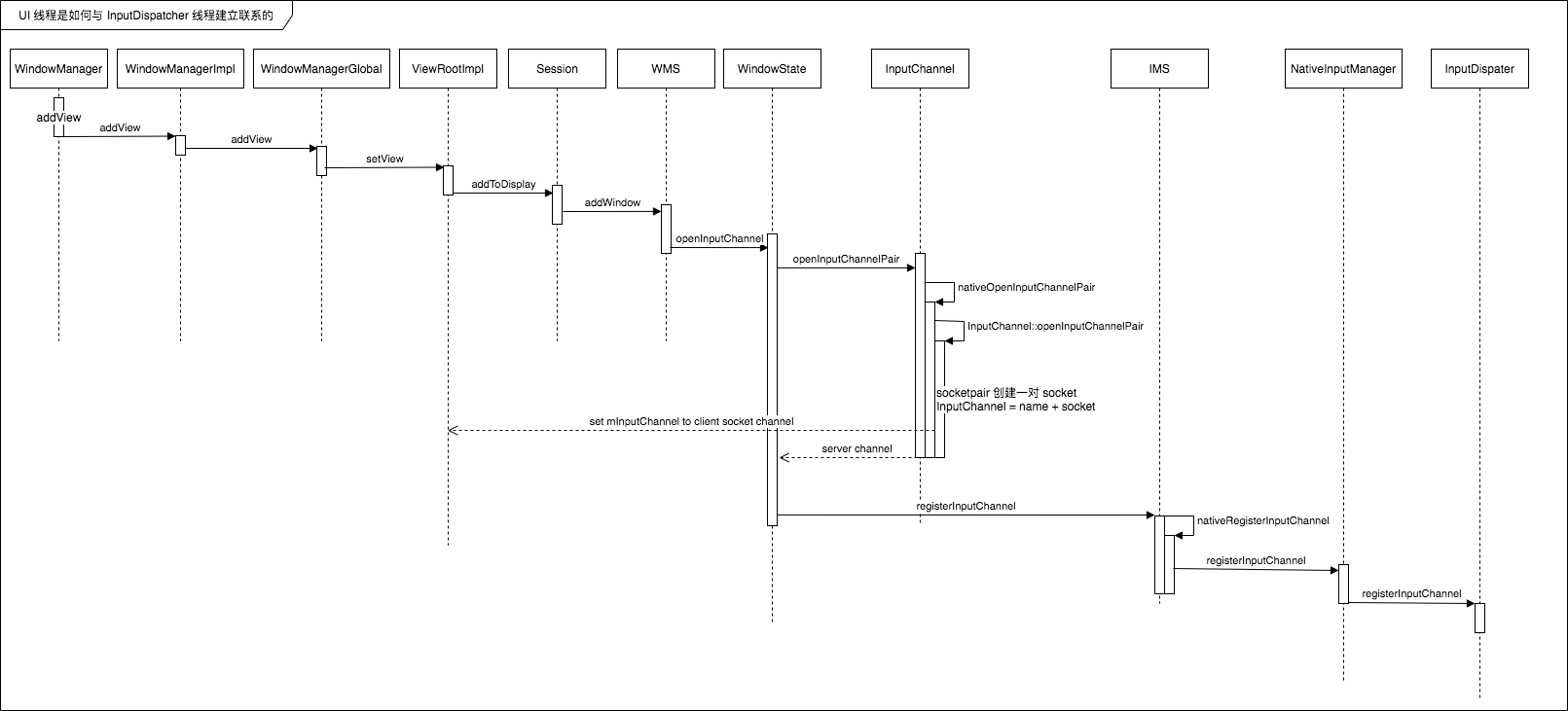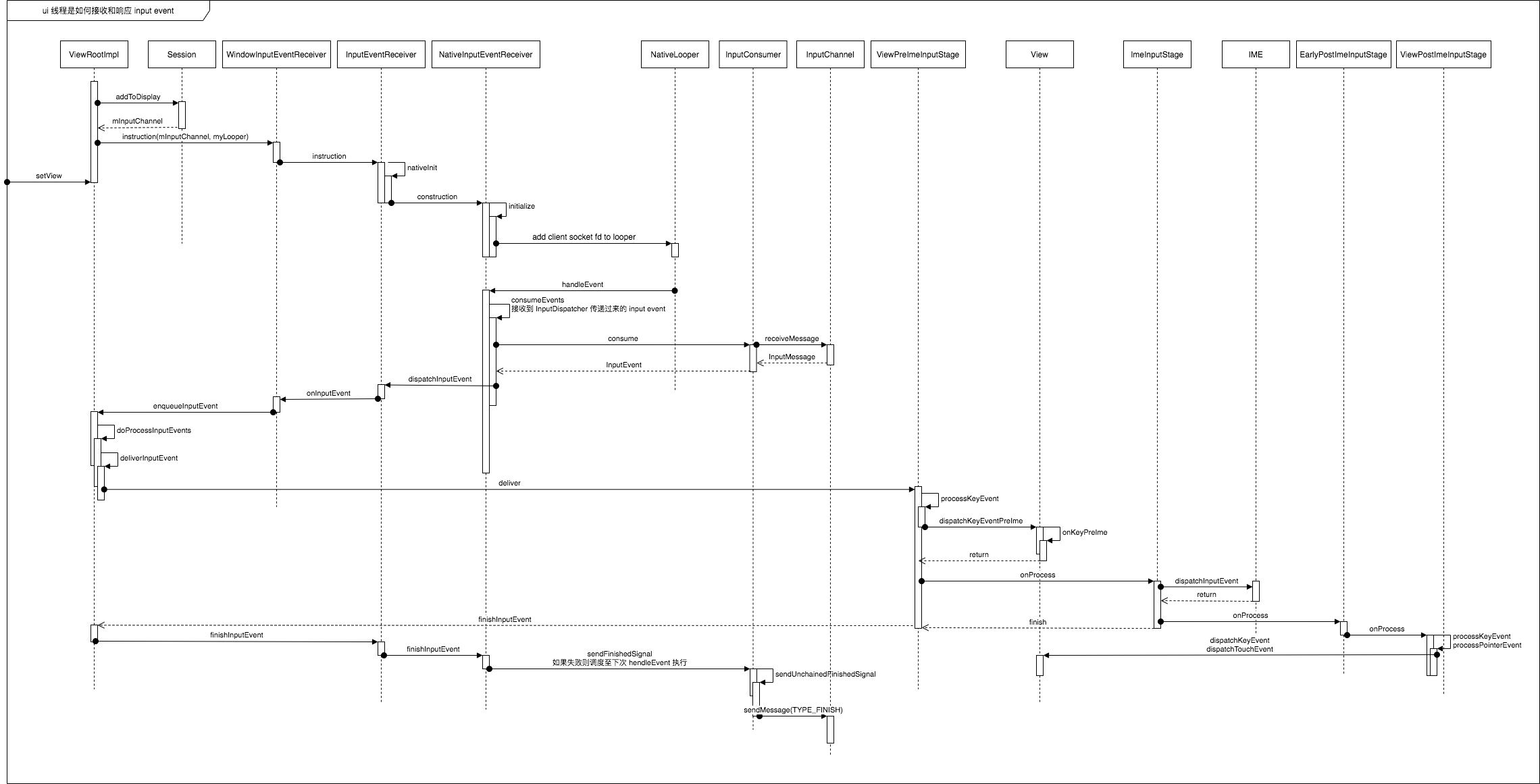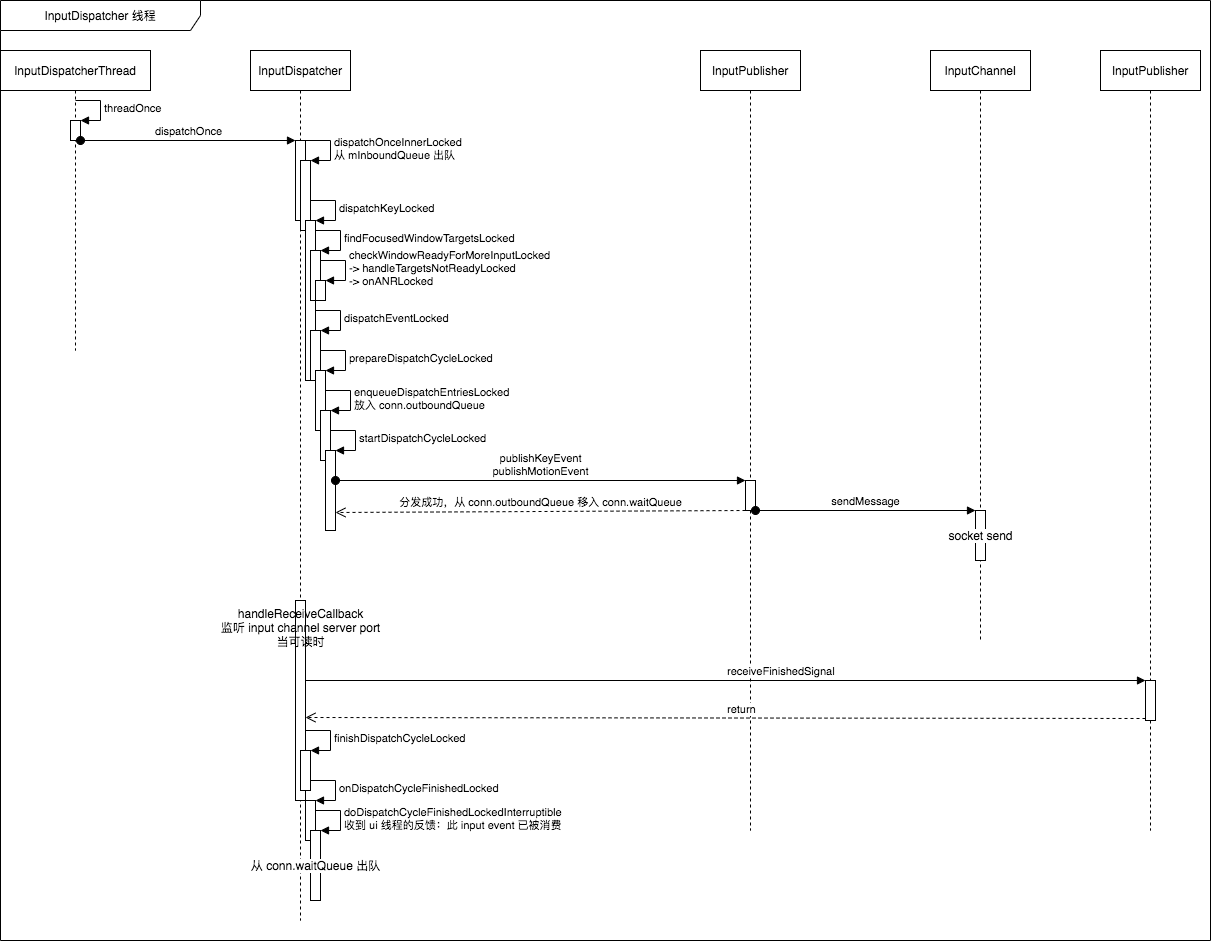阅读源码系列:ANR 是怎么产生的
根据日常的经验我们大概知道,如果 app 没有及时消费 MotionEvent,超过 5s 就会弹出 ANR 对话框;那么 ANR 的逻辑肯定是在事件分发过程中产生的,我们从事件的源头找起,看看 input 事件是怎么产生的
input 的分发

事件分发是从线程 InputReaderThread 开始的,它的主要工作是:
- 从目录
/dev/input获取 input event- 看来 android 的输入设备是挂载在
/dev/input下的,当然会有多个输入设备:屏幕触摸、键盘、手柄等,使用epoll监听多个fd EventHub.getEvents()从fd读取input_event并转换为RawEvent(看来输入设备的驱动都需要构造input_event给系统)
- 看来 android 的输入设备是挂载在
- 经过识别分类(按键、手势、手柄、滚轮等)、过滤等一系列操作后,添加到
mInboundQueue(等待InputDispatcher分发)InputDevice将RawEvent交由各种InputMapper处理,例如:KeyboardInputMapper将RawEvent包装为NotifyKeyArgs,TouchInputMapper将RawEvent包装为NotifyMotionArgsInputDispatcher.notifyXXX将各种NotifyXXXArgs包装为XXXEntry放入mInboundQueue
这里需要补充下 Native Looper 不同于 Java Looper 的地方:提供了监听文件描述符的机制
/**
* @param fd 需要监听的文件描述符
* @param ident 表示为当前发生事件的标识符,必须 >= 0,或者为 POLL_CALLBACK(-2) 如果指定了 callback
* @param events 表示为要监听的文件类型,默认是 EVENT_INPUT
* @param callback 当有事件发生时,会回调该 callback 函数
* @param data
*
* 主要做了两件事:
* 1,把输入参数构造成 Request,添加到 mRequests
* 2,将 fd 添加到 epoll
*
*/
int addFd(int fd, int ident, int events, Looper_callbackFunc callback, void* data);
int addFd(int fd, int ident, int events, const sp<LooperCallback>& callback, void* data);它有两种使用方式:
- 指定 callback 来处理事件 : 当该文件描述符上有事件到来时,该 callback 会被执行;调用
Looper.wake()也会触发 callback 执行
// pollAll() -> pollOnce() -> pollInner()
int eventCount = epoll_wait(mEpollFd.get(), eventItems, EPOLL_MAX_EVENTS, timeoutMillis)
// ...
for (int i = 0; i < eventCount; i++) {
int fd = eventItems[i].data.fd;
uint32_t epollEvents = eventItems[i].events;
if (fd == mWakeEventFd.get()) {
// ...
} else {
ssize_t requestIndex = mRequests.indexOfKey(fd);
if (requestIndex >= 0) {
// ...
pushResponse(events, mRequests.valueAt(requestIndex));
} else {
// ...
}
}
}
// ...
for (size_t i = 0; i < mResponses.size(); i++) {
Response& response = mResponses.editItemAt(i);
if (response.request.ident == POLL_CALLBACK) {
int fd = response.request.fd;
int events = response.events;
void* data = response.request.data;
int callbackResult = response.request.callback->handleEvent(fd, events, data);
if (callbackResult == 0) {
removeFd(fd, response.request.seq);
}
// Clear the callback reference in the response structure promptly because we
// will not clear the response vector itself until the next poll.
response.request.callback.clear();
result = POLL_CALLBACK;
}
}- 通过指定的 ident 来处理事件:当该文件描述符有数据到来时,
pollOnce()会返回一个 ident,调用者会判断该 ident 是否等于自己需要处理的事件 ident,如果是的话,则开始处理事件
// pollAll() -> pollOnce()
for (;;) {
while (mResponseIndex < mResponses.size()) {
const Response& response = mResponses.itemAt(mResponseIndex++);
int ident = response.request.ident;
if (ident >= 0) {
int fd = response.request.fd;
int events = response.events;
void* data = response.request.data;
if (outFd != nullptr) *outFd = fd;
if (outEvents != nullptr) *outEvents = events;
if (outData != nullptr) *outData = data;
return ident;
}
}
// ...
}ui 如何接收和处理 input
在分析事件分发的逻辑之前,我们先看看 ui 线程是怎么接收 input 事件的

可以看到在 native 层打开了一对 socket,server socket fd 给 InputDispatcher 线程,client socket fd 给 ui 线程(ViewRootImpl.mInputChannel),也就是说它们之间通过 socket 双向通讯

- 接收:在 native 层用 Native Looper 监听 client socket fd(epoll),封装成
InputMessage传递给 java 层处理 - 经过一个
InputStage责任链的处理,最终到达我们最熟悉的View.dispatchTouchEvent - 响应:ui 线程在消费完 input event 后,通过双向的 socket 告知 dispatcher 线程;如果此时 client socket 不可写,则将响应保存起来,等待下次 client socket 可写时
- dispatcher - ui 这一段分发过程实际上是异步的,那么整个事件分发的过程也就是异步的,这是 ANR 产生的前提
input 的生命周期

一个 input event 的生命流程大概是这样的:
InputReader放入InputDispatcher.mInboundQueue等待分发InputDispatcher将其移入 window 对应的Connection→outboundQueue等待发送- 发送成功后,移入
Connection→waitQueue等待 ui 线程的确认应答 - 收到确认应答,将 input event 移出
Connection→waitQueue
产生 ANR 的逻辑就在 dispatchKeyLocked(分发一个 input event 的过程)

1,findFocusedWindowTargetsLocked 找到 input event 的分发 window 对象,然后 checkWindowReadyForMoreInputLocked 检查 widnow 是否可以接收 input event,这里截取一段检查逻辑:
// outboundQueue 不为空说明此 window 仍有 input event 未发送,waitQueue 不为空说明有 input event 在消费中(未收到消费完成的响应)
// 也就是说 input event 必须是按顺序分发和消费的,不能乱序
if (eventEntry->type == EventEntry::TYPE_KEY) {
if (!connection->outboundQueue.isEmpty() || !connection->waitQueue.isEmpty()) {
return StringPrintf("Waiting to send key event because the %s window has not "
"finished processing all of the input events that were previously "
"delivered to it. Outbound queue length: %d. Wait queue length: "
"%d.",
targetType, connection->outboundQueue.count(),
connection->waitQueue.count());
}
} else {
if (!connection->waitQueue.isEmpty() &&
currentTime >= connection->waitQueue.head->deliveryTime + STREAM_AHEAD_EVENT_TIMEOUT) {
return StringPrintf("Waiting to send non-key event because the %s window has not "
"finished processing certain input events that were delivered to "
"it over "
"%0.1fms ago. Wait queue length: %d. Wait queue head age: "
"%0.1fms.",
targetType, STREAM_AHEAD_EVENT_TIMEOUT * 0.000001f,
connection->waitQueue.count(),
(currentTime - connection->waitQueue.head->deliveryTime) *
0.000001f);
}
}2,最后走到 AppErrors.handleShowAnrUi 里就是弹出 ANR dialog 的地方
总结
- 三个线程,
InputReader负责监听 input fd,InputDispatcher负责分发给 ui,ui 消费并反馈给InputDispatcher InputReader和InputDispatcher在同一进程,mInboundQueue加锁使用即可;InputDispatcher和 ui 在不同的进程,通过 socket 通讯- 事件分发是一个异步的过程,所以它会在
mInboundQueue(待分发)、outboundQueue(待发送) 和waitQueue(待响应) 之间流转 - input event 必须按顺序分发和消费,一个 input event 在分发前必须等待上一个 input event 的响应,如果等待时间超过 5s 则发生 ANR
- ANR dialog 是在 AMS 进程弹出的
还学到了什么
epoll(或者说 IO 多路复用)ui 线程是通过 socket 与 InputDispatcher 线程交互的,它既要等待 input event(不能阻塞)又要处理 ui 相关工作,靠的就是 epoll;具体来说是 native Looper,因为 epoll 可以同时监听多个 fd;用一个 wakeUpFd + messageQueue,当 enqueueMessage 时往 wakeUpFd 写入,从而唤醒线程处理 message;添加 socket fd,当 socket 可读时,唤醒线程处理 socket 过来的消息,而且还可以同时处理 message 和 socket